




Seattle.
What’s the first thing you think of when I say “Seattle”?
Rain? Coffee? Microsoft? More Rain?
Well, for us locals, one of the best-kept Seattle secrets is our annual “Seattle International Film Festival”. For a few weeks each year, the streets of Seattle turn into our own Cannes Film Festival, a Pacific Northwest response to Sundance.
This year brought a special treat to film-loving Sinophiles: a traveling series of classic Hong Kong Kung Fu films presented under the heading “Heroic Grace: The Chinese Martial Arts Film”. If you think you know martial arts films already, you may be in for a surprise. This collection holds no Bruce Lee, no Jet Li, no Jackie Chan.
Here’s how Cheng-Sim Lim of the UCLA Film and Television Archive describes the festival series:
So you weren’t able to make it to Seattle this year?
Tough luck. In case you want to try and find copies of these films for your own collection, here is the lineup, with descriptions and images courtesy of The Seattle International Film Festival.
Swordswoman of Huangjiang (1930)
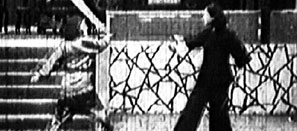 A
vastly entertaining silent forerunner to the sword-and-sorcery
films which would drive the Hong Kong film industry to new
heights some thirty years later, this effervescent period
piece introduces us to Fang Yuquin, who roams the countryside
with her “martial brother” Yue Jianqui, dispensing
aid and protection to people in need. Their exploits lead
them to a foreboding temple, where the way of the jiang hu
(underworld) evoked in the film’s title holds sway over
all who enter.
A
vastly entertaining silent forerunner to the sword-and-sorcery
films which would drive the Hong Kong film industry to new
heights some thirty years later, this effervescent period
piece introduces us to Fang Yuquin, who roams the countryside
with her “martial brother” Yue Jianqui, dispensing
aid and protection to people in need. Their exploits lead
them to a foreboding temple, where the way of the jiang hu
(underworld) evoked in the film’s title holds sway over
all who enter.
Come Drink With Me (1966)
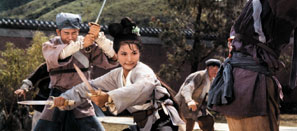 Golden
Swallow confronts Jade-Faced Tiger and his gang. Hiding in
the shadows, Fan Dabei (Yue Hua) rescues her when she’s
hit by a poisonous dart, and cares for her in his little shack
by a waterfall. Romance is in the air, yet these two still
have work to do. In his martial arts directorial debut, King
Hu joins poetics to sophisticated action choreography, ushering
in the “new school” swordplay and the martial
arts film as a major art form.
Golden
Swallow confronts Jade-Faced Tiger and his gang. Hiding in
the shadows, Fan Dabei (Yue Hua) rescues her when she’s
hit by a poisonous dart, and cares for her in his little shack
by a waterfall. Romance is in the air, yet these two still
have work to do. In his martial arts directorial debut, King
Hu joins poetics to sophisticated action choreography, ushering
in the “new school” swordplay and the martial
arts film as a major art form.
The One-Armed Swordsman (1967)
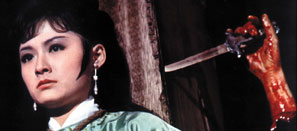 Zhang
Che’s riveting revenge thriller is often identified
as the key transitional film between the old school wuxia
swordplay picture and what we now think of as the kung fu
movie. “The One-Armed Swordsman” created a revolution
in the genre with its innovative emphasis on match-ups among
various fighting styles and the warrior’s training process.
Even in its visual details the film announces the arrival
of a new kind of hero.
Zhang
Che’s riveting revenge thriller is often identified
as the key transitional film between the old school wuxia
swordplay picture and what we now think of as the kung fu
movie. “The One-Armed Swordsman” created a revolution
in the genre with its innovative emphasis on match-ups among
various fighting styles and the warrior’s training process.
Even in its visual details the film announces the arrival
of a new kind of hero.
Golden Swallow (1968)
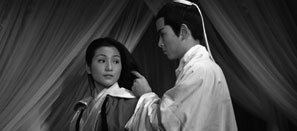 A
nominal sequel to King Hu’s “Come Drink With Me,”
“Golden Swallow” takes its title from the heroine
of Hu’s film but, in line with director Zhang Che’s
proclivity for male-centered stories, reorients the plot around
a tormented swordsman. Zhang emphasizes rough vigor–not
to mention the grislier aspects of violence, including bodily
maiming and psychological trauma.
A
nominal sequel to King Hu’s “Come Drink With Me,”
“Golden Swallow” takes its title from the heroine
of Hu’s film but, in line with director Zhang Che’s
proclivity for male-centered stories, reorients the plot around
a tormented swordsman. Zhang emphasizes rough vigor–not
to mention the grislier aspects of violence, including bodily
maiming and psychological trauma.
Vengeance! (1970)
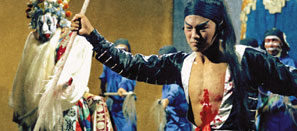 Zhang
combines expressive widescreen camera angles, dynamic editing
and breathtaking use of slow motion to forge a stylized depiction
of mayhem unrivalled outside Peckinpah’s valedictory
Westerns. The film is awash in blood, bright red pools of
it drawn mainly by daggers and hatchets, although firearms
do put in a brief appearance.
Zhang
combines expressive widescreen camera angles, dynamic editing
and breathtaking use of slow motion to forge a stylized depiction
of mayhem unrivalled outside Peckinpah’s valedictory
Westerns. The film is awash in blood, bright red pools of
it drawn mainly by daggers and hatchets, although firearms
do put in a brief appearance.
Intimate Confessions of a Chinese Courtesan (1972)
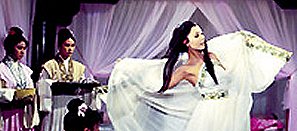 Imagine
relocating a martial arts school–site of many a scene
of tortuous training of would-be warriors–to a brothel,
and transposing the martial arts master to the brothel’s
madam and the martial arts disciple to a prostitute (who must
be forcibly drilled in the sexual arts of servicing men).
Now imagine that the madam is a lesbian who abducts virgins
to work in her brothel. Oh my.
Imagine
relocating a martial arts school–site of many a scene
of tortuous training of would-be warriors–to a brothel,
and transposing the martial arts master to the brothel’s
madam and the martial arts disciple to a prostitute (who must
be forcibly drilled in the sexual arts of servicing men).
Now imagine that the madam is a lesbian who abducts virgins
to work in her brothel. Oh my.
Blood Brothers (1973)
 This
widescreen epic of love, loyalty and betrayal is based on
actual events surrounding the assassination of a general in
the waning years of the Qing Dynasty (late 19th century).
This retelling finds David Jiang and newcomer Chen Guandai
as bandit brothers who befriend the mercenary warrior Di Long
after trying to rob him. Eventually, the threesomes’
devotion grows into jealousy, treachery and revenge that prefigures
his assistant director John Woo’s 1990 “Bullet
in the Head.”
This
widescreen epic of love, loyalty and betrayal is based on
actual events surrounding the assassination of a general in
the waning years of the Qing Dynasty (late 19th century).
This retelling finds David Jiang and newcomer Chen Guandai
as bandit brothers who befriend the mercenary warrior Di Long
after trying to rob him. Eventually, the threesomes’
devotion grows into jealousy, treachery and revenge that prefigures
his assistant director John Woo’s 1990 “Bullet
in the Head.”
The 36th Chamber of Shaolin (1978)
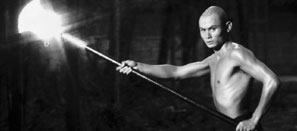 “The
36th Chamber of Shaolin” is the most popular screen
version of one of the key foundation myths of the kung fu
subgenre: the story of the dissemination of the top-secret
combat techniques developed at the Shaolin Temple. A newly
minted monk, now known as San De (”Three Virtues”),
soon demonstrates the truth of the adage that “the mind
is also a muscle”; he invents a new weapon, the three-section
staff, to counter a rival’s “butterfly twin swords”
style.
“The
36th Chamber of Shaolin” is the most popular screen
version of one of the key foundation myths of the kung fu
subgenre: the story of the dissemination of the top-secret
combat techniques developed at the Shaolin Temple. A newly
minted monk, now known as San De (”Three Virtues”),
soon demonstrates the truth of the adage that “the mind
is also a muscle”; he invents a new weapon, the three-section
staff, to counter a rival’s “butterfly twin swords”
style.
Return To the 36th Chamber (1980)
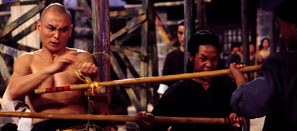 A
freewheeling follow-up to the original, immensely popular
“The 36th Chamber” (1978) this quasi-sequel applies
a light touch to the “warrior-in-training” subgenre
and ably showcases director Lau Kar-leung’s considerable
talent for kung fu comedy. Along with the slapstick kung fu
films of Sammo Hung and Jackie Chan, “Return to the
36th Chamber” helped usher in the vogue for martial
arts comedy in 1980s Hong Kong cinema.
A
freewheeling follow-up to the original, immensely popular
“The 36th Chamber” (1978) this quasi-sequel applies
a light touch to the “warrior-in-training” subgenre
and ably showcases director Lau Kar-leung’s considerable
talent for kung fu comedy. Along with the slapstick kung fu
films of Sammo Hung and Jackie Chan, “Return to the
36th Chamber” helped usher in the vogue for martial
arts comedy in 1980s Hong Kong cinema.
You may still have a chance to see the series … if you’ll be in New York City, Houston, or Portland, Oregon in the next several weeks. The series - including additional films not technically in the traveling series - is now playing through July 10th, 2003 in New York City at The Walter Reade Theatre, in conjunction with The Film Society of Lincoln Center.
After that, two stops remain on the series’ multi-city tour of the USA: Houston, TX (July 11-August 9, 2003), and Portland, OR (July 18-August 9, 2003).
“Heroic Grace: The Chinese Martial Arts Film” touring program has been selected and organized by the UCLA Film and Television Archive, and has been made possible with Presenting Sponsorship from the Hong Kong Economic and Trade Office in San Francisco, and additional sponsorship from Cathay Pacific Airways. Licensed by Celestial Pictures Ltd. (a company incorporated in Hong Kong SAR). All rights reserved.
July 2003